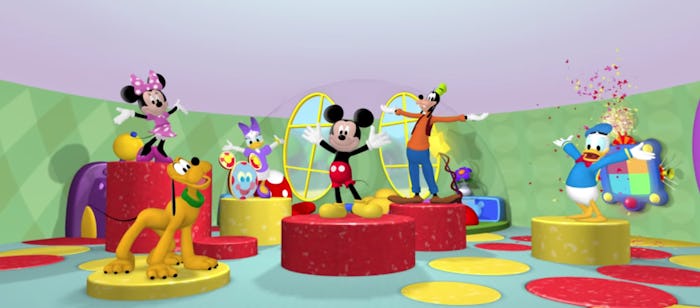Entertainment
Here's Why Your Kid Can't Get Enough Of 'Mickey Mouse Clubhouse' (Hot Dog!)
Mickey Mouse is an iconic figure whose joy and positivity has touched lives for generations. When Walt Disney created Mickey Mouse back in 1928, I seriously doubt he expected such a phenomenon. From Mickey Mouse ice cream bars to 12 Disney theme parks and multiple on-screen hits, Mickey is everywhere. Over the years, the character has evolved and the cartoon image has changed with the times, but his spark of light and hilariously squeaky voice are timeless. Now, the biggest Mickey obsession for preschoolers is the Disney Junior show Mickey Mouse Clubhouse. But why do kids love Mickey Mouse Clubhouse so much? It seems to be most kids' first look at the iconic mouse and they're instantly hooked.
When Mickey Mouse Clubhouse first aired in 2006, it featured Mickey and his pals learning and playing in their mouse-ear-shaped clubhouse. The show ran for a solid 10 years and still airs on Disney Junior daily. I have personally seen my fair share of episodes. My oldest son was obsessed with it during his toddler and preschool years. I could turn on an episode (or two) and he would sit and watch uninterrupted for as long as I would let him. Even as young as 2 years old, he was entertained by the bright colors and constant singing. And apparently, that's why every kid is obsessed.
"Children certainly enjoy the bright colors, sounds, songs, and interactive format of these types of television shows," says Dr. Sarah Hornack, pediatric psychologist, at Children’s National Health System in a recent interview with Romper. "Aspects of these television shows align well with the developmental milestones that children are typically trying to achieve."
Each episode of Mickey Mouse Clubhouse follows Mickey and pals Minnie, Goofy, Pluto, Daisy, and Donald (my personal fav out of the crew) as they embark on adventures to solve problems. A mechanical helper called Toodles helps the gang by supplying "Mouseketools" that are necessary to solve the day's problem. Toodles zips to Mickey's side whenever he calls out, "Oh Toodles!" and allows Mickey and friends to select the Mouseketool right for the job at hand. This could be as silly or simple as decorating for a birthday party or as complex as helping a lost duckling find his way back to his flock.
The concept of basic problem solving is one that is developmentally right on track for toddlers and preschoolers. Dr. Betsy Marks, a pediatrician and internist practicing in Albany, NY, told me why she believes Mickey Mouse Clubhouse is so appealing to kids. "These shows tend to be attractive to kids because they are fun, engaging, but also informative. They require the kids to problem solve, but let them have fun with songs, repetition and make-believe."
Fun songs help to keep kids entertained throughout the entire duration of each episode of Mickey Mouse Clubhouse — and possibly onto the next. The "Hot Dog Dance" song plays at the end of every episode, and is a treat that any kid watching more than one episode can come to expect. The silly song is quite catchy and has most definitely gotten stuck in my own head more times than I would like to admit. This type of repetition and expectation is what keeps kids hooked in.
While that might be great for holding kids' attention and getting them out of their parent's hair for a few minutes, there is definitely something to be said for having too much of a good thing, especially for very young children. "There is absolutely such a thing as too much screen time for children. The AAP recommends that children under age 18 months shouldn't be exposed to any screen time at all with the exception of occasional video chats," Dr. Marks says.
It is recommended that the limited screen time for the target demographic of Mickey Mouse Clubhouse (i.e., toddlers and preschoolers) be shared with an adult in order to encourage learning. "The Disney team is an expert in creating fast-moving, engaging, and colorful programs that appeal to kids, but not necessarily offer benefits. Under the age of 2, kids do not learn from television shows or apps. They may be able to engage or repeat something from the show, but they are unable to translate that learning into a real, 3D world," explains Natasha Burgert, MD, FAAP in an interview with Romper. "The ability to learn improves slightly from the age of 2 to 3 if a parent or caregiver is watching with them, contextualizing the information into the real world for them."
Dr. Marks also agrees with the concept of shared screen time for young children watching shows like Mickey Mouse Clubhouse. "In children over age 2 years, it is recommended that screen time is limited to no more than one hour per day and it is still best if done in a shared environment with a parent or caregiver to foster learning," Dr. Marks says. Considering the universal appeal of Mickey and his crew, that is something I can definitely get on board with.
